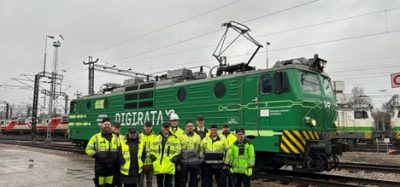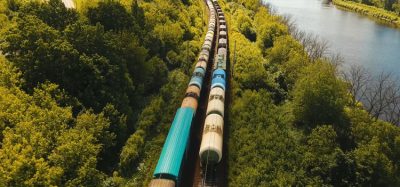Hanzelijn makes the Netherlands even smaller
Posted: 20 February 2013 | | No comments yet
“The Netherlands, here you are” were proud words of the 2012 Dutch Olympic gold medallist Ranomi Kromowidjojo. ProRail can also use the same words when speaking about the Hanzelijn – the newest railway track that the railway manager has built between Lelystad and Zwolle – we are proud of the result.
After the Betuweroute (the freight railway line between Rotterdam and the German border) and the high-speed rail link South (from Amsterdam to the south), the Hanzelijn is the third, and the last for the time being, new large track that was added to the Dutch railway network. Queen Beatrix opened the line on 6 December 2012. From 9 December 2012, the new railway line has been included in the new timetable of transporter NS. ProRail is manager and owner of the railway system in the Netherlands that now covers over 7,000km.
The new track is 50km-long and it was constructed for three main purposes; for better opening-up of the region; for better connection between the north of the country and the region of Amsterdam; and to meet the increasing numbers of railway travellers. Groningen is now 15 minutes closer to Schiphol. One might say: The Netherlands has become a little bit smaller than it used to be. The railway has partly been built on ‘new land’ at the bottom of the former Zuiderzee. Residents and municipalities along the track see opportunities for new regionaleconomic development.
By the book
The line aims to transport 32,000 travellers from 2013. Besides, the Hanzelijn contributes to meeting the increase of mobility on the railway.
Without this new track substantial capacity expansion would have been required on the track of the existing Veluwelijn (Amersfoort- Zwolle). Transport flows from the north can now be spread over two lines which makes the total system less vulnerable.
As far as we are concerned, the Hanzelijn is a railway by the book. Smooth as a billiard cloth, with no level crossings, equipped with ERTMS and suitable for trains to travel on at up to speeds of 200km/h on this section. We have built two beautiful new stations; a splendid vivid red design bridge over the IJssel River and a tunnel under the Dronten Lake nature reserve. We have built the entire line with 88 construction works within the set time and well within budget.
Project management
How did we manage this? When we say that we are proud of the Hanzelijn, we mean, perhaps, that we are particularly proud of the way in which we have constructed it. At the beginning of this millennium, we developed a lot of knowledge and skills in the area of project management when building the Betuweroute; we worked with Design and Construction (D&C) contracts for the first time. This was successful, as the Betuweroute is a great example of a successful infrastructural construction project from an international point of view.
We have continued this learning curve. Professionals involved in the construction of the Betuweroute have spread over various infrastructural projects in the Netherlands, including the Hanzelijn. I happen to be one of them myself. The art is in the transfer of knowledge and experience to new projects, enabling the society to optimally benefit from the experience gained.
This starts with setting up the project organisation. In fact, we divided the organisation, which included approximately 50 people, into two parts: A Project Management Department in the Head Office in Utrecht and an On-Site Construction Management Department in Kampen. In this way, project management was close to the management and exploitation departments that had to take over the railway after construction. This made the mutual alignment easier. In this way, construction management could focus better on the actual construction work. People who functioned on the construction work were not distracted by all kinds of social and political discussions that always happen during such a process. The one department was directed towards the building site, the other towards society. An effective model is established when one succeeds in making those two departments cooperate well.
“The Netherlands, here you are” were proud words of the 2012 Dutch Olympic gold medallist Ranomi Kromowidjojo. ProRail can also use the same words when speaking about the Hanzelijn – the newest railway track that the railway manager has built between Lelystad and Zwolle – we are proud of the result. After the Betuweroute (the freight railway line between Rotterdam and the German border) and the high-speed rail link South (from Amsterdam to the south), the Hanzelijn is the third, and the last for the time being, new large track that was added to the Dutch railway network. Queen Beatrix opened the line on 6 December 2012. From 9 December 2012, the new railway line has been included in the new timetable of transporter NS. ProRail is manager and owner of the railway system in the Netherlands that now covers over 7,000km. The new track is 50km-long and it was constructed for three main purposes; for better opening-up of the region; for better connection between the north of the country and the region of Amsterdam; and to meet the increasing numbers of railway travellers. Groningen is now 15 minutes closer to Schiphol. One might say: The Netherlands has become a little bit smaller than it used to be. The railway has partly been built on ‘new land’ at the bottom of the former Zuiderzee. Residents and municipalities along the track see opportunities for new regionaleconomic development. By the book The line aims to transport 32,000 travellers from 2013. Besides, the Hanzelijn contributes to meeting the increase of mobility on the railway. Without this new track substantial capacity expansion would have been required on the track of the existing Veluwelijn (Amersfoort- Zwolle). Transport flows from the north can now be spread over two lines which makes the total system less vulnerable. As far as we are concerned, the Hanzelijn is a railway by the book. Smooth as a billiard cloth, with no level crossings, equipped with ERTMS and suitable for trains to travel on at up to speeds of 200km/h on this section. We have built two beautiful new stations; a splendid vivid red design bridge over the IJssel River and a tunnel under the Dronten Lake nature reserve. We have built the entire line with 88 construction works within the set time and well within budget. Project management How did we manage this? When we say that we are proud of the Hanzelijn, we mean, perhaps, that we are particularly proud of the way in which we have constructed it. At the beginning of this millennium, we developed a lot of knowledge and skills in the area of project management when building the Betuweroute; we worked with Design and Construction (D&C) contracts for the first time. This was successful, as the Betuweroute is a great example of a successful infrastructural construction project from an international point of view. We have continued this learning curve. Professionals involved in the construction of the Betuweroute have spread over various infrastructural projects in the Netherlands, including the Hanzelijn. I happen to be one of them myself. The art is in the transfer of knowledge and experience to new projects, enabling the society to optimally benefit from the experience gained. This starts with setting up the project organisation. In fact, we divided the organisation, which included approximately 50 people, into two parts: A Project Management Department in the Head Office in Utrecht and an On-Site Construction Management Department in Kampen. In this way, project management was close to the management and exploitation departments that had to take over the railway after construction. This made the mutual alignment easier. In this way, construction management could focus better on the actual construction work. People who functioned on the construction work were not distracted by all kinds of social and political discussions that always happen during such a process. The one department was directed towards the building site, the other towards society. An effective model is established when one succeeds in making those two departments cooperate well.
“The Netherlands, here you are” were proud words of the 2012 Dutch Olympic gold medallist Ranomi Kromowidjojo. ProRail can also use the same words when speaking about the Hanzelijn – the newest railway track that the railway manager has built between Lelystad and Zwolle – we are proud of the result.
After the Betuweroute (the freight railway line between Rotterdam and the German border) and the high-speed rail link South (from Amsterdam to the south), the Hanzelijn is the third, and the last for the time being, new large track that was added to the Dutch railway network. Queen Beatrix opened the line on 6 December 2012. From 9 December 2012, the new railway line has been included in the new timetable of transporter NS. ProRail is manager and owner of the railway system in the Netherlands that now covers over 7,000km.
The new track is 50km-long and it was constructed for three main purposes; for better opening-up of the region; for better connection between the north of the country and the region of Amsterdam; and to meet the increasing numbers of railway travellers. Groningen is now 15 minutes closer to Schiphol. One might say: The Netherlands has become a little bit smaller than it used to be. The railway has partly been built on ‘new land’ at the bottom of the former Zuiderzee. Residents and municipalities along the track see opportunities for new regionaleconomic development.
By the book
The line aims to transport 32,000 travellers from 2013. Besides, the Hanzelijn contributes to meeting the increase of mobility on the railway.
Without this new track substantial capacity expansion would have been required on the track of the existing Veluwelijn (Amersfoort- Zwolle). Transport flows from the north can now be spread over two lines which makes the total system less vulnerable.
As far as we are concerned, the Hanzelijn is a railway by the book. Smooth as a billiard cloth, with no level crossings, equipped with ERTMS and suitable for trains to travel on at up to speeds of 200km/h on this section. We have built two beautiful new stations; a splendid vivid red design bridge over the IJssel River and a tunnel under the Dronten Lake nature reserve. We have built the entire line with 88 construction works within the set time and well within budget.
Project management
How did we manage this? When we say that we are proud of the Hanzelijn, we mean, perhaps, that we are particularly proud of the way in which we have constructed it. At the beginning of this millennium, we developed a lot of knowledge and skills in the area of project management when building the Betuweroute; we worked with Design and Construction (D&C) contracts for the first time. This was successful, as the Betuweroute is a great example of a successful infrastructural construction project from an international point of view.
We have continued this learning curve. Professionals involved in the construction of the Betuweroute have spread over various infrastructural projects in the Netherlands, including the Hanzelijn. I happen to be one of them myself. The art is in the transfer of knowledge and experience to new projects, enabling the society to optimally benefit from the experience gained.
This starts with setting up the project organisation. In fact, we divided the organisation, which included approximately 50 people, into two parts: A Project Management Department in the Head Office in Utrecht and an On-Site Construction Management Department in Kampen. In this way, project management was close to the management and exploitation departments that had to take over the railway after construction. This made the mutual alignment easier. In this way, construction management could focus better on the actual construction work. People who functioned on the construction work were not distracted by all kinds of social and political discussions that always happen during such a process. The one department was directed towards the building site, the other towards society. An effective model is established when one succeeds in making those two departments cooperate well.
Less delay
Early recognition of the risks and anticipation on this will make or break risk management. It often happened in the past that projects were delayed because of archaeological findings. We were able to prevent this during the con – struction of the Hanzelijn. The Archaeological Project Leader was included in the project team and involved in all planning agreements from the very beginning. Having such a person in – volved in the project makes cooperation a lot easier. This creates mutual understanding. The same holds for the cooperation between the public emergency services. This makes it easier to structure their input with fewer surprises, higher quality and less delay.
We opted for D&C contracts. In this we went to the extreme with respect to the complex capacity expansion (40%) of the station of Lelystad. The entire work was described in one contract: Expansion of a complex roof construction, platforms, lifts, layout of the station hall, railway, retaining walls, track work, security and overhead wire. The work was performed while the station was operational as usual. Of course, the risks were in the alignment of all these sub-projects. In order to keep everything together, we gave the building contractor the maximum management of the construction process. This was a very positive experience.
Environmental management
Project management is one thing – the relation with the environment is something completely different. Building 50km of railway takes along 100km of new neighbours with whom a good relationship is to be built up. Of course, this was not easy; expropriations have taken place too and a railway will make noise along and in residential areas. One has to be careful towards everybody, not just towards protesting groups. It should be avoided that all attention is paid to those who shout loudest.
The region was already convinced of the necessity of the railway, but there were some opposed to it – people who felt aggrieved. It is important to take this minority very seriously. Issues about fitting the railway in the landscape involve a project of public interest. One is entitled to acquire land compulsorily. This is quite something, especially in a country like the Netherlands, where every metre is made use of. This requires attention and accuracy.
Beautiful bridge
I think a nice example of successful environ – mental management is the way in which we have been able to construct a beautiful bridge from an architectural point of view near Hattem. At the start, the municipality wanted a tunnel instead of a bridge. However, politics opted for a bridge, particularly in view of the costs. The Minister promised that one beautiful bridge would be built over the IJssel near Hattem, for which extra money was made available.
Therefore, five magnificent and very diverse designs were submitted. The scale-models were exhibited in the town halls and an independent committee of experts, mostly architects, assessed the design based on the criteria set. There is now a magnificent award-winning bridge in place. Everyone is happy with it. ProRail and the contractors (because we have demonstrated our ability in making a selection based on quality) and also the municipalities and their inhabitants (who actually preferred a tunnel) are now proud of their bridge.
A safe railway
The Hanzelijn is not just beautiful, it is also safe. We have provided the section with the European ERTMS system as well as with the Dutch ATB system. At the moment, many trains are not equipped with ERTMS yet, but there is a political resolution for imple – mentation of this in the entire railway system in the Netherlands. Another important safety aspect is the absence of level crossings on this new track. This will not only prevent a lot of accidents and casualties, but will also contribute to reducing the number of disturbances in the timetable. A choice for safety is therefore also the choice for two separate tunnel tubes under the Dronten Lake. This is an important choice for safety, apart from all technical systems, for this avoids the chance of train collisions.
A beautiful railway
We have opted for visually pleasing architecture in many places. The structure of the Dronten tunnel has been awarded with the international Brunel architecture prize. The new stations of Kampen South and Dronten are also character – ised by fine design. Fifty years after the first ‘pioneers’ settled in the new polder municipality of Dronten, they can now for the first time reach their own municipality by train. This may well be called a milestone.
The Hanzelijn in figures
Track length: 50km
Number of construction works: 88
Number of railway sleepers: 140,000
Number of level crossings: 0
Baffle boards: 20km
Municipalities: Lelystad, Dronten, Kampen, Hattem, Zwolle
Provinces: Flevoland, Gelderland, Overijssel
Investment costs: €1.1 billion
Biography
Jaap Balkenende has been Project Manager of the Hanzelijn project since the start of construction in 2006. In this role, Jaap managed a multi – disciplinary project team and he consulted with the client, the Ministry of Infrastructure and the Environment, the Department of Waterways and Public Works and regional and local governments. Jaap previously worked in maintenance and management of NS Railinfrabeheer (later known as ProRail) between 1978 and 1989, then as Director of Implementation on the Betuweroute project until 2006.







